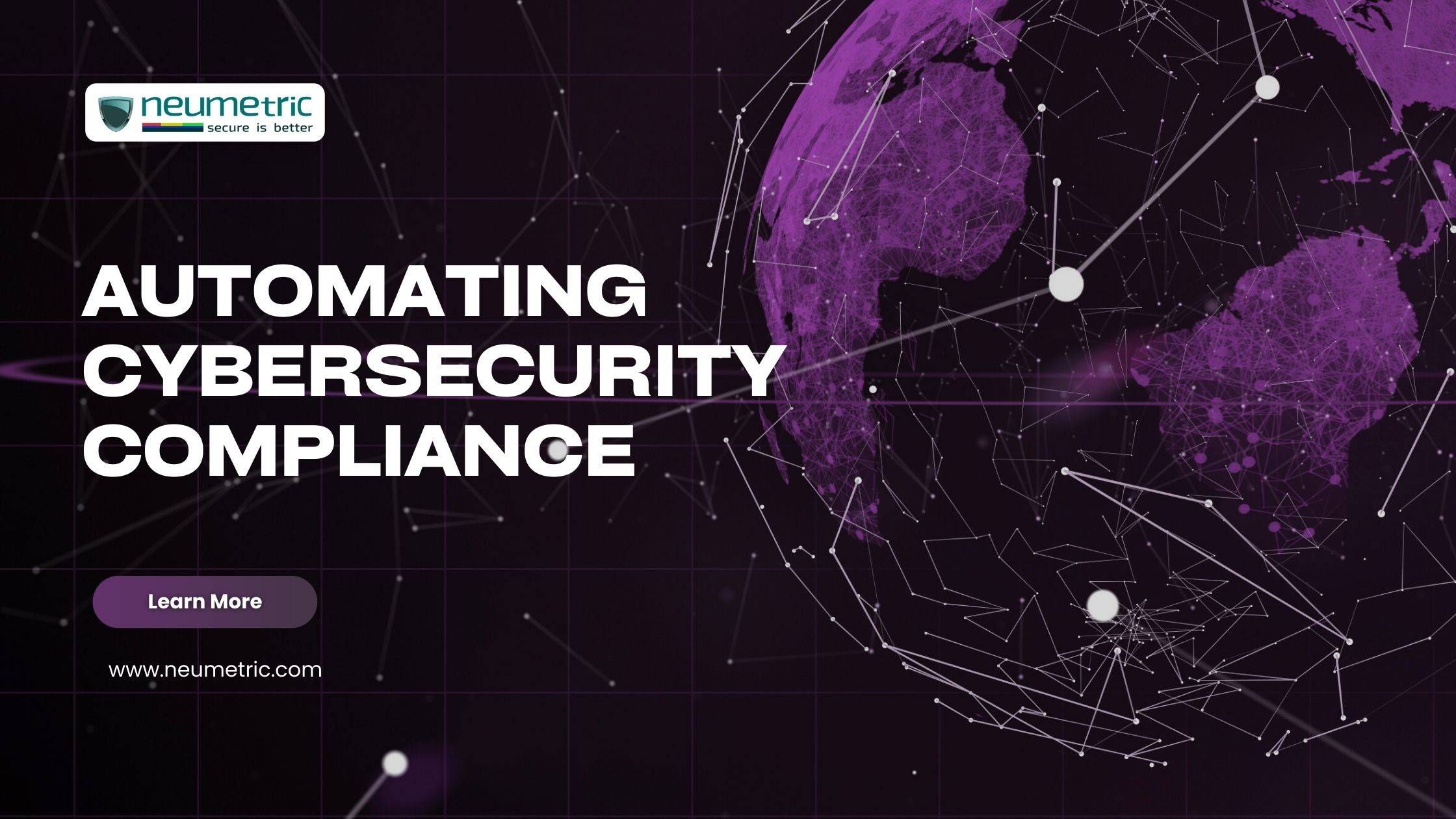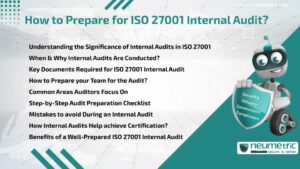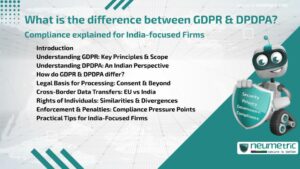Table of Contents
ToggleIntroduction
In the ever-evolving landscape of cybersecurity, where threats are dynamic & regulations are stringent, the need for an efficient & adaptive approach to compliance management has never been more pronounced. Automating cybersecurity compliance emerges as a strategic response to this challenge, integrating cutting-edge technologies to streamline processes, enhance accuracy & fortify the resilience of organisations against evolving threats.
Automating cybersecurity compliance involves leveraging technological solutions & tools to streamline & enhance the process of ensuring that an organisation’s information systems adhere to relevant cybersecurity standards, regulations & policies. This approach integrates automation to facilitate continuous monitoring, assessment & reporting of security controls, ultimately reducing manual efforts & improving the efficiency of compliance management.
As we delve into the realm of automating cybersecurity compliance, we explore the integral components, measures, advantages & potential drawbacks of this approach. From monitoring to policy enforcement, the various facets of automation contribute to a comprehensive framework designed to not only meet regulatory requirements but also to proactively respond to emerging cyber threats.
Elements of automating cybersecurity compliance
- Continuous monitoring: Continuous monitoring involves real-time surveillance & analysis of the organisation’s IT infrastructure to identify security events, vulnerabilities & deviations from established security baselines. Automated tools continuously collect & analyse data from various sources, providing immediate insights into the security posture & enabling prompt responses to potential threats.
- Automated auditing: Automated auditing encompasses the use of tools to systematically assess & verify adherence to cybersecurity policies, regulatory requirements & industry standards. These tools automate the auditing process, ensuring consistency & accuracy in evaluating security controls, configurations & access permissions.
- Policy enforcement: Policy enforcement in the context of cybersecurity involves the consistent application of security policies across an organisation’s IT environment to mitigate risks & ensure compliance. Automated policy enforcement tools monitor & enforce security policies, ensuring that configurations & user activities align with established security standards.
- Security Information & Event Management [SIEM]: SIEM integrates security information management & event management to provide a comprehensive view of an organisation’s security events & incidents. SIEM tools automate the collection, analysis & correlation of security event data, offering real-time insights into potential threats & facilitating compliance monitoring.
- Vulnerability scanning: Vulnerability scanning involves the systematic identification & assessment of weaknesses in an organisation’s systems, networks or applications. Automated vulnerability scanning tools conduct regular scans, identify vulnerabilities & prioritise them based on risk, enabling organisations to address security gaps promptly.
- Policy automation: Policy automation refers to the use of automated tools to create, manage & update cybersecurity policies within an organisation. These tools streamline the creation & enforcement of security policies, ensuring that policies are consistently applied & adapted to evolving threats & compliance requirements.
- Configuration management: Configuration management involves the systematic management of configurations across IT assets to maintain a secure & compliant state. Automated configuration management tools monitor & enforce security configurations, ensuring that systems & devices adhere to predefined security baselines.
- Incident response automation: Incident response automation involves the use of automated workflows & processes to respond to & mitigate security incidents promptly. Automated incident response tools help orchestrate & coordinate response actions, reducing response times & minimising the impact of security incidents.
- Reporting & documentation: Automated reporting & documentation involve the generation of comprehensive reports & documentation detailing the organisation’s cybersecurity compliance status, activities & improvements. Automated tools compile data, create compliance reports & maintain documentation, facilitating audits, regulatory reporting & internal reviews.
- Threat intelligence integration: Integrating threat intelligence involves automating the ingestion & analysis of real-time threat data to enhance cybersecurity decision-making & compliance measures. Automated systems incorporate threat intelligence feeds, allowing organisations to dynamically adjust their cybersecurity controls based on the latest threat landscape.
- Patch management automation: Patch management automation entails the automated identification, testing & deployment of security patches across an organisation’s software & systems. Automated patch management tools help organisations stay current with software updates, addressing vulnerabilities promptly & ensuring compliance with security best practices.
- Automated user access reviews: Automated user access reviews involve regularly assessing & validating user permissions & access rights using automated tools. Automated reviews help ensure that user access aligns with least privilege principles, reducing the risk of unauthorised access & enhancing compliance with data protection regulations.
- Encryption key management: Encryption key management automation involves the automated generation, distribution & rotation of cryptographic keys used to secure sensitive data. Automated key management ensures that encryption processes remain secure & compliant with industry standards, reducing the risk of unauthorised access to sensitive information.
- Compliance workflow automation: Compliance workflow automation streamlines the workflow processes associated with managing, monitoring & demonstrating compliance. Automated workflows improve efficiency by orchestrating tasks, approvals & validations, ensuring a structured & auditable approach to compliance activities.
- Automated security awareness training: Automated security awareness training involves using automated platforms to deliver, track & manage cybersecurity training programs for employees. Automated training programs help organisations educate employees on security best practices, ensuring a well-informed workforce to support compliance efforts.
- Regulatory change management: Regulatory change management automation involves monitoring & adapting to changes in cybersecurity regulations & standards. Automated tools track regulatory updates, assess their impact on existing controls & support the efficient implementation of necessary changes to maintain compliance.
- Automated security policy documentation: Automated security policy documentation involves the generation & maintenance of up-to-date documentation outlining an organisation’s cybersecurity policies. Automated tools ensure that security policies are documented, accessible & aligned with compliance requirements, aiding in audits & regulatory assessments.
- Integration with Identity & Access Management [IAM]: Integration with IAM involves automating the synchronisation of user identities & access privileges across systems & applications. Automated IAM integration ensures that user access is consistently managed, reducing the risk of unauthorised access & contributing to compliance with access control requirements.
- Cloud security automation: Cloud security automation involves the automation of security controls & compliance measures within cloud environments. Automated tools support the configuration, monitoring & enforcement of security controls in cloud infrastructure, ensuring compliance with cloud security standards.
- Automated security incident documentation: Automated security incident documentation involves the automated creation of detailed records following a security incident. Automated incident documentation tools help organisations capture critical details of security incidents, aiding in post-incident analysis, reporting & compliance documentation.
These integral parts of automating cybersecurity compliance collectively contribute to a comprehensive & proactive security framework. By leveraging automation, organisations can not only enhance their ability to meet compliance requirements but also strengthen their overall cybersecurity posture in the face of an ever-evolving threat landscape.
Advantages of automating cybersecurity compliance:
- Efficiency & accuracy: Automation reduces manual errors & accelerates compliance processes, ensuring accurate & efficient adherence to cybersecurity standards.
- Real-time visibility: Continuous monitoring provides real-time visibility into the security posture of the organisation, allowing for immediate response to emerging threats.
- Resource optimization: Automation frees up human resources by handling routine compliance tasks, enabling cybersecurity professionals to focus on more complex security challenges.
Despite the advantages, it is essential to acknowledge the potential challenges. The complexity of implementation, the risk of false positives & initial costs are considerations that organisations must address judiciously. Striking the right balance between automation & human expertise becomes pivotal, ensuring that the technology augments, rather than replaces, the insights & decision-making capabilities of cybersecurity professionals.
- Complex Implementation: Implementing automated compliance solutions can be complex, requiring expertise in both cybersecurity & the specific tools being utilised.
- Potential False Positives: Automated tools may generate false positives, leading to unnecessary investigations & diverting resources from critical security issues.
- Cost of Implementation: Initial costs associated with acquiring & implementing automated compliance tools may be a barrier for some organisations.
Future-Proofing Automated Compliance in a Dynamic Threat Landscape:
In the realm of cybersecurity, the term “future-proofing” refers to the strategic planning & implementation of measures that anticipate & adapt to future challenges, ensuring that systems & processes remain effective & relevant over time. Future-proofing automated compliance in a dynamic threat landscape involves adopting strategies & technologies that can withstand evolving cyber threats & regulatory changes.
Adaptive Security Measures: Adaptive security involves the ability of a system to dynamically adjust its security measures in response to changing threat landscapes. Incorporating Machine Learning [ML] & Artificial Intelligence [AI] allows automated compliance systems to analyse patterns, learn from incidents & adapt security measures in real-time. This adaptive capability ensures that the system can proactively respond to emerging threats without manual intervention.
Continuous Monitoring & Threat Intelligence: Continuous monitoring involves real-time surveillance of systems, networks & data. Threat intelligence is the knowledge about potential & current cyber threats. Automated compliance systems should integrate continuous monitoring tools & threat intelligence feeds. This enables organisations to stay informed about the latest threats, vulnerabilities & attack methodologies, allowing them to adjust their compliance measures promptly.
Dynamic Regulatory Compliance Mapping: Regulatory compliance requirements are dynamic & subject to change due to legislative updates or emerging standards. Automated compliance solutions should have the capability to dynamically map & adjust to changes in regulatory requirements. Regular updates & real-time tracking of compliance changes ensure that the system remains aligned with the latest legal & industry standards.
Integration of Predictive Analytics: Predictive analytics involves using data, statistical algorithms & machine learning techniques to identify the likelihood of future outcomes. By integrating predictive analytics, automated compliance systems can forecast potential threats & vulnerabilities based on historical data & trends. This proactive approach helps organisations implement preventive measures before new threats materialise.
Scalability & Flexibility: Scalability refers to the system’s ability to handle growth & increased demand. Flexibility involves adaptability to changes in requirements. Future-proof automated compliance systems should be scalable to accommodate the growth of an organisation & flexible enough to adapt to changes in the IT landscape, business processes & compliance requirements.
Investment in Emerging Technologies: Emerging technologies, such as quantum computing, blockchain & secure cloud solutions, may impact the future cybersecurity landscape. Organisations should invest in technologies that are not only robust in the current context but also have the potential to evolve & address future challenges. This might include exploring quantum-resistant encryption, decentralised identity solutions & secure cloud architectures.
Holistic Risk Management: Holistic risk management involves considering all potential risks to an organisation’s assets, including cybersecurity risks. Future-proofing requires a comprehensive risk management approach. Automated compliance systems should integrate risk assessment tools, enabling organisations to identify, prioritise & mitigate risks effectively. This approach ensures a proactive stance against potential threats.
Fusion, a cybersecurity compliance product developed by Neumetric, helps organisations achieve regulatory compliance with ease! Click here to know more about how Fusion can help your Organisation.
Conclusion:
In conclusion, the journey toward automated cybersecurity compliance is a transformative one, shaping a future where organisations not only meet regulatory mandates but proactively safeguard their digital assets. This evolution empowers cybersecurity teams to focus on strategic initiatives, harnessing technology to navigate the complexities of compliance with agility & resilience.
Automating cybersecurity compliance is a crucial step in adapting to the dynamic threat landscape. While it streamlines processes & enhances efficiency, careful consideration of the organisation’s specific needs & potential challenges is essential for successful implementation. A balanced approach that combines automation with human expertise ensures a robust cybersecurity compliance framework.
FAQs:
What types of cybersecurity compliance tasks can be automated?
Tasks such as vulnerability assessments, policy enforcement & continuous monitoring can be automated to enhance cybersecurity compliance.
How does automation improve the accuracy of compliance assessments?
Automation reduces the risk of human errors in compliance assessments by consistently applying predefined rules & policies, ensuring accuracy & reliability.
Are there industry-specific compliance standards that benefit from automation?
Yes, industries such as healthcare [HIPAA], finance [PCI DSS] & government [NIST] can benefit significantly from automating compliance processes to meet their specific regulatory requirements.
Can automated compliance tools adapt to changing cybersecurity regulations?
Yes, many automated tools (such as Fusion) are designed to update & adapt to changing regulations, ensuring that organisations remain compliant with the latest cybersecurity standards.
What considerations should organisations keep in mind when implementing automated compliance solutions?
Organisations should consider the complexity of their IT infrastructure, the specific compliance requirements applicable to their industry & the potential integration challenges when implementing automated compliance solutions.





